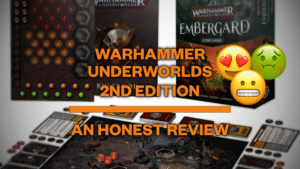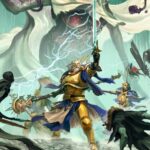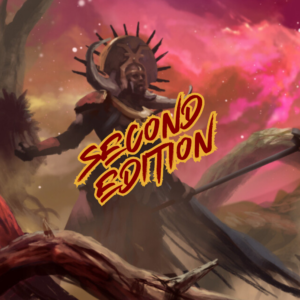
The concept of taking more cards than the standard, minimum deck size of 12 objective cards and 20 power cards has been floated out there a couple times since the launch of Embergard. It caught my eye and I wanted to spend some time working through the pros and cons, how the rule set of the new version enables some differences in deck construction, and when and how you might look to build a larger than normal deck. We’re going to start with the power deck and move to the objectives later.
By The Numbers
Let’s start off with the basics. In CCGs, TCGs and other games where you come with a pre-built deck, it’s best practice to stick to the minimum deck size. This is due to the probability of card draw. With the absolute minimum deck size, you’ve got the best chance to draw the most powerful cards in the deck as well as drawing the tool you need in a certain situation. Using the Underworlds power deck, you start with 5 cards in hand and 15 in your deck, so the chances of drawing a specific card is 1/15 (6.67%). And as you add more cards to the deck, the further you reduce those odds.
Why is that so important? Well, for starters, your deck is built to support your game plan. And as you add more and more cards, the important cards to have the effects you want are less likely to come up with any consistency. If you’re counting on ping damage or pushes, but you’ve got a number of other cards filling your hand instead, you won’t be as effective in a given round. Duplicate effects are a good way to build consistency in your deck, so that you’re never stuck without what you need.
What I’ve found with second edition is that the mulligan rules help immensely with your odds of getting a better opening hand. Let’s say you draw a power hand with 4 upgrades and 1 ploy and would like to mulligan it. Drawing the first card from your deck is a 50/50 to get a ploy or upgrade (with a 20 card power deck). If you’ve put those cards aside, on your new hand of 5 cards, you’re pulling on 9/15 being ploys and 6/15 upgrades, giving you now a 60/40 chance, with the most common redraw being 3 ploys and 2 upgrades. Not only that, but shuffling potential late game effects back into your deck is much better than losing them outright.
That being said, playing more than the minimum deck size won’t matter unless you’re taking advantage of some sort of card draw, which we’ll explore in the next section.
Frenzy of Greed
First off, there’s the extra card you get for losing a roll off. There’s no way to really count on these three cards swinging your way during a game, other than being the underdog in rounds two and three will reduce your odds. They’re part of the overall mix, but not everything. I’d probably think of this as 1 extra card a game that I’m almost guaranteed, and if that number drops to zero, it means I had control of turn order the whole game. To reframe my thoughts on that, if a ploy said “decide who goes first next round”, I would see it as playable.
Next up, focus. Replacing the ability to simply draw one card, we now have access to the ability to cycle through cards. Simply put, having a bad draw (either off of an initial mulligan or into rounds two and three) is less of a block than in the past. Having the ability to draw one power card to search for what you need is great. But now, you can discard cards that aren’t helping (thinking of you Twist the Knife once Great Strength or Bladecatcher are equipped) and replace them as well.
An example scenario is that you’re in the last few actions of round three and you have Living Bludgeon in hand as your last surge. You’ve got a charged fighter and you’re needing to grant them a guard token. Let’s also say that you’ve got good reason to not be charged out, as in a fighter had a move action, or can’t get off a token because you need to score Supremacy. You know that you’ve got Braced in the last three cards of your deck but not in your hand. Instead of having to draw cards one by one to have a 33% chance to pick up Braced, you can discard two power cards and guarantee you’ll get it. That’s a powerful line to be able to take so that you can get exactly what you need out of the deck.
Let’s look at warscroll abilities that grant card draw. Out of our pool of 33 warbands, we’ve got 10 warbands able to draw from their warscroll. From these ten, we have five of them that grant a one time draw. Da Kunnin’ Krew’s only grants one card, Looncourt’s grants two cards, Razors can be shut down by the opponent, Khagra can have up to five cards (but likely gets two to three), and Daggok could get up to nine (but likely gets two to three).
The remaining five warbands have a potential of getting cards more than once. But just because they’re repeatable, doesn’t mean they’re equal. Hexbane’s Hunters could draw extra cards on marked kills but then they aren’t removing charge tokens. Ephilim will likely get a couple of cards from the minions dying and being raised, but will have to control positioning tightly.
The three warbands that I see the most consistent with extra draw are Ylthari, the Headsmen’s Curse, and Zondara’s Gravebreakers. Ylthari has their fun little mini-game of inspiration with getting on average two extra cards per round (either from your deck, or ditching cards from hand to cycle through faster). Headsmen can target larger bounty fighters to attempt to get 2-3 cards each round depending on matchup. Zondara has insane utility with drawing cards on their delving based on dead fighters, potentially 6-8 cards a round!

Lastly, in the first six Rivals decks, there are three cards that allow you extra draw. Remember, that when taking these cards, that they should ideally be net positive so that you aren’t spending one card to gain one card. Lost Legacy is really limiting in the fact that you have to have a fighter die with upgrades and you get that upgrade back. So that it’s a positive draw, it lets you draw alongside it. I’ll be honest, if it worked with Utter Ignorance I could see playing this, but it’ll likely be left in the dust. Burnt Out makes you apply the upgrade, give a stagger token and use a core action. I think that the options from focus are just as strong (unless you have an empty hand). By the Numbers will clearly see the most play. Alongside the fact that you’ll be wanting to hold treasure tokens, this is easily 2, 3 or sometimes 4 cards.
To conclude this section, the easiest warbands to have a larger power deck with would be Gravebreakers (due to the strong warscroll draw) Ylthari (I hope my cards sprout!) and Khagra (will want to be on tokens for By the Numbers and their warscroll draw). Others could still potentially play more than 20, likely talking 22 for an extra upgrade and extra ploy. I’d consider it if you’ve got a Take & Hold warband (Emberstone makes it easier), a 3 to 4 fighter warband (allows you more space for a focus action) or anyone with some innate draw.
Objective

With the objective deck, the mulligan math we discussed above becomes even more skewed in your favour. Drawing 3 end phase objectives in the initial hand means that you’ve got 6/9 cards being surges and 3/9 being end phase left in the deck. You’ll be likely to get 2 surges and 1 end phase as your redraw. This is crucial now as you don’t lose out on the ability to score higher glory end phase cards, they just go back in the deck so that you can plan towards them later. If you increase that deck to 13 objectives (6 surges is always the absolute limit), the odds on these cards become 6/10 and 4/10, giving you a similar 60/40 odds on this deck. Because you’re only ever going to score a maximum of three end phase objectives each turn, having a seventh to score in your deck is achievable to increase your glory ceiling, but potentially at the cost of not rolling through your surges.
When it comes to using focus for objective cards, it’s easy to ditch some hard to score cards for the potential to draw into what you need. A nice to have is that you can discard multiple objectives for new ones, and net an extra power card at the same time. I’ve found myself using focus to ensure that I can be as efficient as possible. The real thing I can see focus enabling is high risk, high reward objectives. I’m thinking Strip the Realm, Unrelenting Massacre, Alone in the Dark, Stay Close and more. These have some counterplay and would take most of the round to help set up. If you can get the proper board state, you could attempt to focus into these objectives. And if not, you can discard them to get something that you can make work.
Last point, remember that if you score three end phase cards at the end of both round 1 and round 2, then you’ll only potentially have surges left in your deck. There’s a maximum of 9 end phase cards you can score each game. Finding that sweet spot between 6 and 9 is the goal. How often are you short on end phase cards in round 3? Are you discarding ones often, so effectively they’re already clogging up the deck? Depending on your speed of burning through the deck, the ease of scoring, you might be able to justify 7 or maybe even 8 end phase cards.
Deck Support
There are definite limitations in Nemesis when it comes to having larger decks. It’s nice that you might be able to take 25 power cards or 14 objectives, but are those cards actually any good? Do they play into your strategy at all? Are they counter to what your warband is actually doing? Looking at deckbuilding, it’s really the combination of decks that also need to be balanced to work. The first Nemesis pairing I was playing around with was Blazing Assault and Emberstone Sentinels. When I was deckbuilding, I found surges easy, end phase slightly limited, ploys bountiful and yet I had a hard time finding a clear tenth upgrade. There wasn’t a hard decision where I was looking to pick between two different upgrades and either would be great. Really consider your card pool before just throwing cards into a deck.
One last thing that I want to put out there is that it’s easy to get locked into the standard formula of your deck. But there are players out there trying different and innovative things. It’s of note that the deck that Daniele Gorini won the ‘24 Worlds with (found here) only had 5 surge objectives! That’s a departure from the standard 6 and 6 and I think is truly a sign of building proper deck consistency, rather than sticking to accepted norms.
The End Phase
In conclusion, I think there are some good reasons to decide to play outside of the minimum, traditional deck compositions. Card draw isn’t gated behind one or two universal cards, or locked into a specific Rivals deck. Between mulligans and focus, there are strong interactions you can have with the way your deck comes out. Make sure you’re weighing all the factors before diving straight into a larger card pool. And if you do try it out, check how many objectives are left unscored (or unseen as you didn’t draw into them). Make sure to count how many power cards are left in your deck at the end of your games, that way you can see how consistently you’re getting through to all your cards.
What are your thoughts? Are you going to expand your decks here and there? Is 12 and 20 still the only way to play? Let me know your thoughts. I’m on the Discords as Matt ~ Set The Tempo, or reach out to me at setthetempoblog@gmail.com. And make sure to set your own tempo!
















